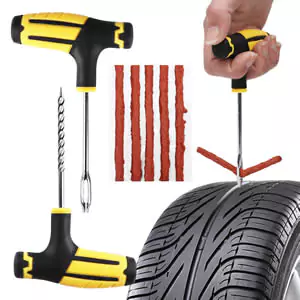Tire Repair Kit
A tire repair kit is an essential tool for any driver, offering a convenient and efficient solution for fixing punctures and minor damages to vehicle tires without the need for immediate professional help. Understanding the different types of tire repair kits, their importance, what to consider when choosing one, and how to properly use it can significantly enhance your preparedness for roadside emergencies.
Tire Repair Kit Types
There are several types of tire repair kits available, each suited to different types or severities of tire damage:
- Plug Kits: Ideal for repairing punctures in the tread area of the tire. These kits include rubber plugs, an insertion tool, and sometimes a reaming tool to clean the hole before repair.
- Patch Kits: Used for larger punctures or damages that plugs cannot adequately seal. Patch kits require the tire to be removed from the rim to apply the patch from the inside.
- Sealant Kits: Contain a tire sealant that is injected into the tire through the valve stem, sealing punctures from the inside. Many new vehicles come with these kits in lieu of spare tires.
- Combination Kits: Offer both plugs and sealant, providing a more comprehensive solution for different types of tire damage.

Importance of Tire Repair Kit
The significance of having a tire repair kit includes:
- Convenience: Allows for quick and immediate repairs on the go, reducing downtime and the need to seek immediate professional assistance.
- Cost-Effective: Using a tire repair kit for minor punctures can save money on towing services and professional repair costs.
- Safety: Enables drivers to address tire issues promptly, reducing the risk of driving on a flat tire and potentially preventing accidents.
- Peace of Mind: Having a tire repair kit in your vehicle ensures that you're prepared for unexpected tire problems, offering a sense of security during travels.
Choosing the Right Tire Repair Kit
When selecting a tire repair kit, consider the following factors:
- Type of Damage: Choose a kit based on the most common types of tire damage you encounter. If unsure, a combination kit offers more versatility.
- Ease of Use: Look for kits with clear instructions and user-friendly tools, especially if you're not experienced with tire repairs.
- Quality and Durability: High-quality materials in your repair kit will ensure that the fixes are durable and reliable.
- Kit Contents: Ensure the kit includes all necessary tools and materials for the type of repairs it's designed for. Additional accessories like gloves or a tire gauge can be beneficial.
- Portability: Consider the size and weight of the kit, especially if space is limited in your vehicle.
Buy quality tire repair kit on Amazon and eBay.
How to Use a Tire Repair Kit
While the specific steps can vary depending on the kit type, the general process for using a tire repair kit is as follows:
- Locate the Damage: Identify the puncture or damaged area on the tire. Remove any debris or objects causing the puncture.
- Prepare the Tire: For plug kits, use the reaming tool to clean and widen the hole. For patch kits, this involves removing the tire from the rim.
- Apply the Repair: For plug kits, thread the plug through the insertion tool, apply rubber cement (if included), and insert it into the puncture. For sealant kits, inject the sealant through the valve stem according to the kit's instructions. For patch kits, apply the patch to the inside of the tire.
- Seal and Reinflate: Once the repair is in place, reinflate the tire to the recommended pressure.
- Check for Leaks: After the repair, check the tire for any signs of air leakage.
- Temporary Solution: Remember, most tire repairs made with a kit are temporary. Visit a professional tire repair service as soon as possible for a thorough inspection and permanent repair.
Tire repair kits are indispensable tools for drivers, offering a quick fix for unexpected tire damage and the ability to get back on the road with minimal delay. By understanding the types of kits available, what to consider when choosing one, and how to properly use it, drivers can ensure they are prepared for most roadside tire emergencies.
All listed guides, data and/or calculations are for informational purposes only. TirePressure.com does not warrant or make any representations regarding the accuracy of or the results of the use of this information.